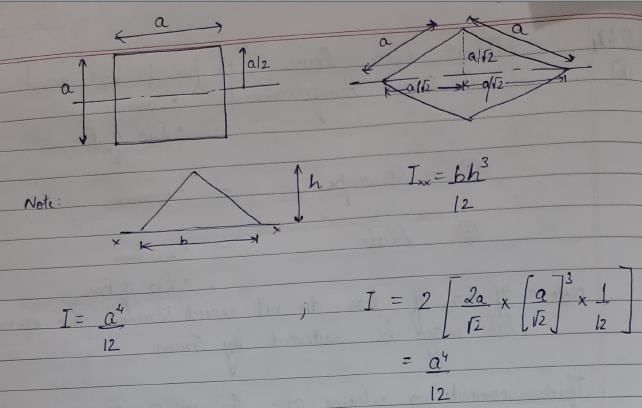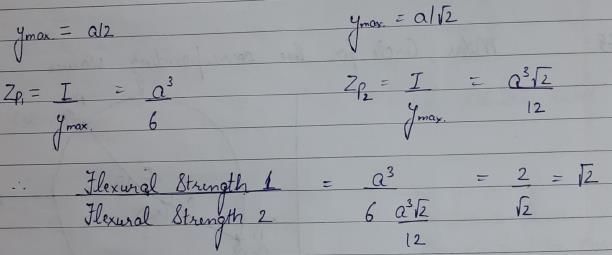Civil Engineering (CE) Exam > Civil Engineering (CE) Questions > The ratio of the flexural strengths of two sq...
Start Learning for Free
The ratio of the flexural strengths of two square beams one placed with two sides horizontal and the other placed with one diagonal vertical and other horizontal is
- a)√2
- b)√3
- c)√5
- d)1/√2
Correct answer is option 'A'. Can you explain this answer?
Most Upvoted Answer
The ratio of the flexural strengths of two square beams one placed wit...


Free Test
FREE
| Start Free Test |
Community Answer
The ratio of the flexural strengths of two square beams one placed wit...
√2 : 1
Let us assume that the two square beams have the same dimensions and are made of the same material.
Case 1: Two sides horizontal
In this case, the beam is supported by two edges and the load is applied at the center. The beam will bend along the vertical axis passing through the center. The maximum stress will be at the bottom of the beam and will be given by:
σ = (M*c)/I
where σ is the stress, M is the bending moment, c is the distance from the neutral axis to the bottom of the beam, and I is the moment of inertia of the beam.
The moment of inertia of a square beam about its horizontal axis passing through the center is given by:
I = (1/12)*b*h^3
where b is the width of the beam and h is the height of the beam.
In this case, b = h and c = h/2, so:
I = (1/12)*h*h^3 = (1/12)*h^4
The bending moment M can be calculated as:
M = F*(h/2)
where F is the load applied at the center of the beam.
Therefore, the maximum stress is:
σ = (F*h/2)*(h/2)/[(1/12)*h^4] = 6*F*h/[(h^3)]
Case 2: One diagonal vertical and other horizontal
In this case, the beam is supported by one edge and the load is applied at the center. The beam will bend along the diagonal axis passing through the center. The maximum stress will be at the bottom of the beam and will be given by:
σ = (M*c)/I
where σ is the stress, M is the bending moment, c is the distance from the neutral axis to the bottom of the beam, and I is the moment of inertia of the beam.
The moment of inertia of a square beam about its diagonal axis passing through the center is given by:
I = (1/6)*b*h^3
where b is the width of the beam and h is the height of the beam.
In this case, b = h and c = (h/2)*√2, so:
I = (1/6)*h*(h^3) = (1/6)*h^4
The bending moment M can be calculated as:
M = F*(h/√2)
Therefore, the maximum stress is:
σ = (F*h/√2)*[(h/2)*√2]/[(1/6)*h^4] = 3*√2*F/h^2
Ratio of flexural strengths:
Flexural strength is the maximum stress that a material can withstand before it breaks under bending. Therefore, the ratio of the flexural strengths of the two square beams is given by:
(Flexural strength of the beam with two sides horizontal)/(Flexural strength of the beam with one diagonal vertical and other horizontal) = (6*F*h/[(h^3)])/(3*√2*F/h^2) = 2√2 : 1
Therefore, the ratio of the flexural strengths of the two square beams is 2√2 : 1.
Let us assume that the two square beams have the same dimensions and are made of the same material.
Case 1: Two sides horizontal
In this case, the beam is supported by two edges and the load is applied at the center. The beam will bend along the vertical axis passing through the center. The maximum stress will be at the bottom of the beam and will be given by:
σ = (M*c)/I
where σ is the stress, M is the bending moment, c is the distance from the neutral axis to the bottom of the beam, and I is the moment of inertia of the beam.
The moment of inertia of a square beam about its horizontal axis passing through the center is given by:
I = (1/12)*b*h^3
where b is the width of the beam and h is the height of the beam.
In this case, b = h and c = h/2, so:
I = (1/12)*h*h^3 = (1/12)*h^4
The bending moment M can be calculated as:
M = F*(h/2)
where F is the load applied at the center of the beam.
Therefore, the maximum stress is:
σ = (F*h/2)*(h/2)/[(1/12)*h^4] = 6*F*h/[(h^3)]
Case 2: One diagonal vertical and other horizontal
In this case, the beam is supported by one edge and the load is applied at the center. The beam will bend along the diagonal axis passing through the center. The maximum stress will be at the bottom of the beam and will be given by:
σ = (M*c)/I
where σ is the stress, M is the bending moment, c is the distance from the neutral axis to the bottom of the beam, and I is the moment of inertia of the beam.
The moment of inertia of a square beam about its diagonal axis passing through the center is given by:
I = (1/6)*b*h^3
where b is the width of the beam and h is the height of the beam.
In this case, b = h and c = (h/2)*√2, so:
I = (1/6)*h*(h^3) = (1/6)*h^4
The bending moment M can be calculated as:
M = F*(h/√2)
Therefore, the maximum stress is:
σ = (F*h/√2)*[(h/2)*√2]/[(1/6)*h^4] = 3*√2*F/h^2
Ratio of flexural strengths:
Flexural strength is the maximum stress that a material can withstand before it breaks under bending. Therefore, the ratio of the flexural strengths of the two square beams is given by:
(Flexural strength of the beam with two sides horizontal)/(Flexural strength of the beam with one diagonal vertical and other horizontal) = (6*F*h/[(h^3)])/(3*√2*F/h^2) = 2√2 : 1
Therefore, the ratio of the flexural strengths of the two square beams is 2√2 : 1.

|
Explore Courses for Civil Engineering (CE) exam
|

|
Question Description
The ratio of the flexural strengths of two square beams one placed with two sides horizontal and the other placed with one diagonal vertical and other horizontal isa)√2b)√3c)√5d)1/√2Correct answer is option 'A'. Can you explain this answer? for Civil Engineering (CE) 2025 is part of Civil Engineering (CE) preparation. The Question and answers have been prepared according to the Civil Engineering (CE) exam syllabus. Information about The ratio of the flexural strengths of two square beams one placed with two sides horizontal and the other placed with one diagonal vertical and other horizontal isa)√2b)√3c)√5d)1/√2Correct answer is option 'A'. Can you explain this answer? covers all topics & solutions for Civil Engineering (CE) 2025 Exam. Find important definitions, questions, meanings, examples, exercises and tests below for The ratio of the flexural strengths of two square beams one placed with two sides horizontal and the other placed with one diagonal vertical and other horizontal isa)√2b)√3c)√5d)1/√2Correct answer is option 'A'. Can you explain this answer?.
The ratio of the flexural strengths of two square beams one placed with two sides horizontal and the other placed with one diagonal vertical and other horizontal isa)√2b)√3c)√5d)1/√2Correct answer is option 'A'. Can you explain this answer? for Civil Engineering (CE) 2025 is part of Civil Engineering (CE) preparation. The Question and answers have been prepared according to the Civil Engineering (CE) exam syllabus. Information about The ratio of the flexural strengths of two square beams one placed with two sides horizontal and the other placed with one diagonal vertical and other horizontal isa)√2b)√3c)√5d)1/√2Correct answer is option 'A'. Can you explain this answer? covers all topics & solutions for Civil Engineering (CE) 2025 Exam. Find important definitions, questions, meanings, examples, exercises and tests below for The ratio of the flexural strengths of two square beams one placed with two sides horizontal and the other placed with one diagonal vertical and other horizontal isa)√2b)√3c)√5d)1/√2Correct answer is option 'A'. Can you explain this answer?.
Solutions for The ratio of the flexural strengths of two square beams one placed with two sides horizontal and the other placed with one diagonal vertical and other horizontal isa)√2b)√3c)√5d)1/√2Correct answer is option 'A'. Can you explain this answer? in English & in Hindi are available as part of our courses for Civil Engineering (CE).
Download more important topics, notes, lectures and mock test series for Civil Engineering (CE) Exam by signing up for free.
Here you can find the meaning of The ratio of the flexural strengths of two square beams one placed with two sides horizontal and the other placed with one diagonal vertical and other horizontal isa)√2b)√3c)√5d)1/√2Correct answer is option 'A'. Can you explain this answer? defined & explained in the simplest way possible. Besides giving the explanation of
The ratio of the flexural strengths of two square beams one placed with two sides horizontal and the other placed with one diagonal vertical and other horizontal isa)√2b)√3c)√5d)1/√2Correct answer is option 'A'. Can you explain this answer?, a detailed solution for The ratio of the flexural strengths of two square beams one placed with two sides horizontal and the other placed with one diagonal vertical and other horizontal isa)√2b)√3c)√5d)1/√2Correct answer is option 'A'. Can you explain this answer? has been provided alongside types of The ratio of the flexural strengths of two square beams one placed with two sides horizontal and the other placed with one diagonal vertical and other horizontal isa)√2b)√3c)√5d)1/√2Correct answer is option 'A'. Can you explain this answer? theory, EduRev gives you an
ample number of questions to practice The ratio of the flexural strengths of two square beams one placed with two sides horizontal and the other placed with one diagonal vertical and other horizontal isa)√2b)√3c)√5d)1/√2Correct answer is option 'A'. Can you explain this answer? tests, examples and also practice Civil Engineering (CE) tests.

|
Explore Courses for Civil Engineering (CE) exam
|

|
Signup for Free!
Signup to see your scores go up within 7 days! Learn & Practice with 1000+ FREE Notes, Videos & Tests.























